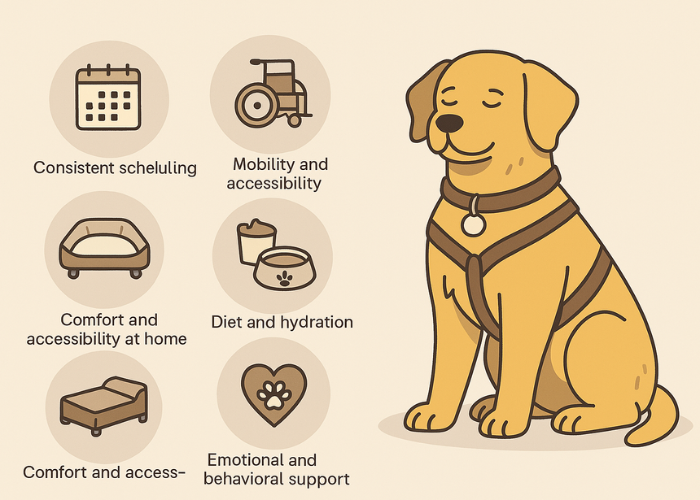Have you ever sworn your dog knew you were coming home minutes before you arrived? Or felt they understood your sadness without a word spoken? Many dog owners share stories that suggest their canine companions possess an almost mystical “sixth sense,” an uncanny ability to perceive things beyond our normal understanding. But is it truly extrasensory perception, or is there a scientific explanation rooted in their remarkable known senses?
This article delves into the fascinating world of canine perception, exploring the science behind your dog’s seemingly intuitive understanding of human emotions and intentions. We’ll uncover how their extraordinary senses of smell, hearing, and observation work together, creating a rich tapestry of perception that often mimics intuition.
The Power of Scent: Smelling Emotions and Health Changes
At the forefront of a dog’s sensory world is their incredible sense of smell, estimated to be tens of thousands to millions of times more sensitive than ours. This olfactory prowess isn’t just for tracking squirrels or finding hidden treats; it plays a crucial role in deciphering the complex world of human emotions and physiology.
Detecting Emotional States Through Chemo-signals
Humans constantly release volatile organic compounds (VOCs) through breath and sweat, and the composition of these VOCs changes subtly depending on our emotional state. Fear, stress, happiness – each emotion carries a unique chemical signature. Dogs, with their highly developed olfactory systems, are capable of detecting these minute changes. Studies suggest dogs can literally smell fear or stress on a person, picking up on the specific chemical markers released during these states. This isn’t mind-reading; it’s advanced chemical detection, allowing them to sense shifts in our mood long before we might overtly express them.
Sensing Illness and Physiological Changes
Beyond emotions, dogs’ noses can detect subtle physiological changes associated with various medical conditions. There’s growing evidence supporting their ability to detect certain cancers, shifts in blood sugar levels in diabetics, or even the onset of seizures through scent alone. While often anecdotal, these accounts highlight the sheer power of their olfactory system to perceive biological changes invisible to us, further contributing to the mystique of their “sixth sense.”
Acute Hearing: Tuning into Subtle Sounds and Vocal Nuances
Beyond their olfactory prowess, dogs possess highly acute hearing that significantly contributes to their perception of our world and our states. They can hear a much wider range of frequencies than humans, including sounds in the ultrasonic range, and their ability to detect faint sounds at greater distances is far superior.
Anticipating Events Through Sound
This auditory sensitivity allows them to pick up on cues that completely escape our notice. A dog might hear the specific engine sound of their owner’s car from blocks away, or the familiar jingle of keys and leash long before the owner consciously signals an impending walk. This ability to detect subtle sounds contributes significantly to their knack for anticipating routine events, which can easily be mistaken for prediction.
Interpreting Human Vocalizations
Furthermore, dogs are incredibly sensitive to the nuances of human vocalizations. They pay close attention to our tone of voice, pitch, rhythm, and volume, learning to associate different vocal patterns with specific emotional states – the cheerful tone of praise, the sharp edge of anger, the soft cadence of sadness, or the high-pitched excitement signaling playtime. They can even pick up on subtle changes in our breathing patterns, perhaps detecting the shallow, rapid breaths associated with anxiety or the deep, slow breaths of sleep or relaxation. This auditory sensitivity allows them to gather a wealth of information about our mood and intentions simply by listening, adding another layer to their perceived intuition.
Keen Observation: Masters of Reading Body Language
Complementing their powerful noses and ears is their keen sense of sight and their mastery of observation. Having evolved alongside humans for tens of thousands of years, dogs have become exceptionally adept at reading our non-verbal cues, often understanding our intentions and emotions through body language even better than through our words.
Deciphering Posture and Gestures
They watch our posture intently, recognizing the difference between a relaxed, confident stance and tense, hunched shoulders that might signal stress or fear. They learn to interpret our gestures, understanding the meaning of pointing, recognizing hand signals used in training, and associating specific movements with outcomes, such as reaching for the leash indicating an upcoming walk.
Understanding Facial Expressions
Research, such as studies published in resources like the National Center for Biotechnology Information (NCBI), has confirmed that dogs are particularly sensitive to human emotions and can differentiate between human facial expressions, particularly distinguishing between happy and angry faces. They are skilled at making eye contact and following human gaze, using it as a cue to locate objects of interest or understand what has captured our attention. Some researchers even speculate that dogs might be sensitive to human micro-expressions – fleeting, involuntary facial movements that betray underlying emotions. By integrating these visual observations with the information gathered through scent and sound, dogs create a remarkably comprehensive picture of our emotional state and intentions. They aren’t reading minds, but they are reading us – our scents, our sounds, our movements, our expressions – with an acuity that often feels like intuition.
Learning and Routine: The Final Pieces of the Puzzle
This complex tapestry of sensory perception is further woven together by the power of associative learning and a strong attunement to routine. Dogs are masters at forming associations. They quickly learn that certain cues reliably predict specific events.
Associative Learning in Action
The sound of the kibble bag rustling means food is coming, the owner putting on specific shoes signals a run, the jingle of keys precedes a departure, and a particular time of day might herald the owner’s return from work. This ability to learn through association allows them to anticipate events based on preceding environmental cues.
The Role of Routine
Combined with their natural sensitivity to daily schedules and routines, this often creates the compelling illusion of prediction. The dog who waits by the door five minutes before you arrive home isn’t psychic; they likely heard your car from afar, recognized the time of day, or picked up on other subtle cues associated with your return. Therefore, the seemingly extraordinary “sixth sense” is, in reality, the synergistic effect of multiple highly developed senses working in concert with learned associations and an acute awareness of patterns and routines. It’s not one single superpower, but rather the integration of olfactory, auditory, and visual data, processed through a brain wired to detect patterns relevant to their social bond with humans.
Conclusion: Extraordinary Senses, Not Extrasensory Perception
So, while the notion of a dog possessing extrasensory perception or telepathic abilities is a romantic one, there is currently no credible scientific evidence to support it. The explanations rooted in their known, albeit extraordinary, biological senses and cognitive abilities are sufficient to account for most, if not all, instances of apparent canine intuition.
However, debunking the myth of a sixth sense should not diminish our awe of dogs’ perceptive capabilities. In fact, understanding the science behind their abilities arguably makes their connection to us even more impressive. It highlights the incredible ways they have adapted to perceive and navigate their world, particularly their intricate social world shared with humans. Their capacity to smell our emotions, hear our subtle cues, read our body language, and learn our routines is a testament to the depth of the human-dog bond and the remarkable co-evolutionary journey we have shared. This profound perceptual connection, built on finely tuned senses rather than magic, is the true foundation of their loyalty, empathy, and seemingly intuitive understanding of their human companions.
Appreciating the science behind their abilities enhances, rather than lessens, the wonder of the human-animal bond. It encourages us to be more mindful of the subtle signals we constantly send and to marvel at the incredible ways our dogs read and respond to us, solidifying their place as truly perceptive and empathetic partners.



